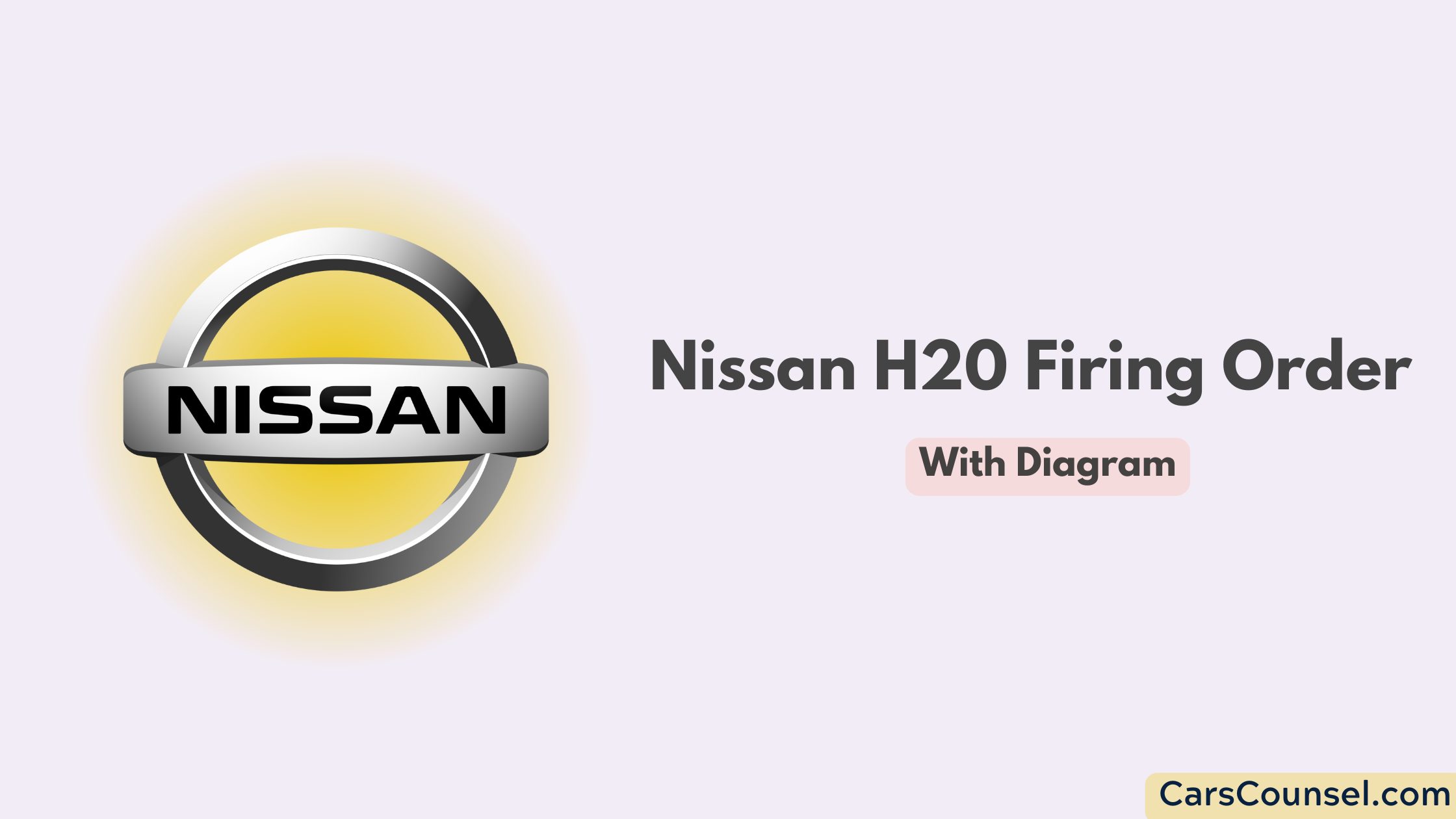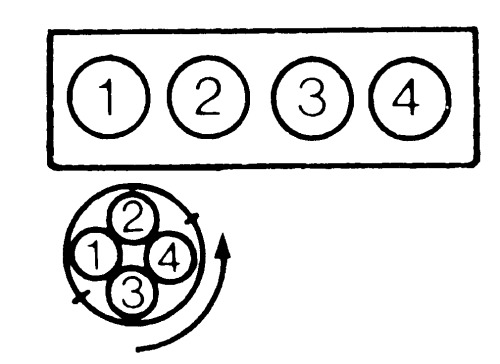The Nissan H20 engine, a robust and reliable inline-four engine, is commonly found in forklifts, industrial equipment, and light commercial vehicles. Known for its simplicity and durability, this engine is easy to maintain and capable of handling demanding workloads.
A key factor in its performance is the firing order, the sequence in which the engine’s cylinders fire to generate power.
This guide provides an in-depth look at the Nissan H20 firing order, why it matters, and how to maintain and troubleshoot it effectively. Whether you’re a technician, operator, or enthusiast, this article will help you master the firing order of this dependable engine.

Quick Navigation
The Nissan H20 Firing Order
The firing order for the Nissan H20 engine is: 1-3-4-2

How the Firing Order Works
- Cylinder 1 Fires First: The cylinder closest to the radiator initiates the combustion cycle.
- Cylinder 3 Fires Second: The third cylinder, skipping the second, fires next.
- Cylinder 4 Fires Third: The rearmost cylinder ignites after Cylinder 3.
- Cylinder 2 Fires Last: The second cylinder completes the cycle before returning to Cylinder 1.
This firing order ensures that power strokes are distributed evenly, balancing the engine’s operation and providing consistent performance.
Why Nissan Uses the 1-3-4-2 Firing Order
The 1-3-4-2 firing order is specifically chosen for inline-four engines like the H20 due to its inherent advantages:
- Smooth Performance: Alternating combustion events across the cylinders minimizes vibrations and improves stability.
- Efficient Combustion: Proper spacing between ignitions ensures complete burning of the air-fuel mixture.
- Simplified Design: The inline-four layout naturally complements this firing sequence.
- Engine Longevity: Distributes mechanical stress evenly, reducing wear on internal components like the crankshaft and bearings.
What Is a Firing Order?
The firing order refers to the specific sequence in which an engine’s cylinders fire, or ignite the air-fuel mixture. In the case of a four-cylinder engine like the Nissan H20, this sequence ensures that power is evenly distributed across the crankshaft, minimizing vibrations and maximizing efficiency.
Why the Firing Order Is Important
- Smooth Operation: A proper firing sequence ensures even combustion, reducing engine vibrations.
- Efficient Performance: Optimized ignition timing delivers steady power and fuel efficiency.
- Durability: Correct firing reduces wear and tear on the crankshaft and internal components.
- Balance: A proper sequence maintains stability in the engine’s operation.
Overview of the Nissan H20 Engine
The Nissan H20 engine is a 2.0-liter inline-four, often used in forklifts, generators, and light-duty vehicles. Its robust design and simple construction make it a preferred choice for industrial applications.
Key Features of the Nissan H20 Engine
- Inline-Four Layout: Four cylinders aligned in a straight line.
- Overhead Valve (OHV) Design: Utilizes pushrods to control the intake and exhaust valves.
- Carbureted Induction: Mixes air and fuel via a carburetor for combustion.
- Cylinder Numbering:
- Cylinder 1 is at the front (closest to the radiator).
- Cylinder 4 is at the rear (closest to the firewall).
Identifying the Firing Order
Understanding the cylinder numbering and firing order is essential for proper maintenance and troubleshooting.
Cylinder Numbering
The cylinders are numbered from front to rear:
- Cylinder 1: Closest to the radiator.
- Cylinder 4: Closest to the firewall.
Distributor Orientation
The distributor rotor controls the ignition sequence. Spark plug wires must be routed from the distributor cap to the correct cylinders in the 1-3-4-2 sequence.
Symptoms of an Incorrect Firing Order
An incorrect firing order can cause noticeable engine performance issues. Early recognition of these symptoms can help prevent further complications.
Common Symptoms
- Engine Misfires: Cylinders fail to ignite properly, causing uneven power delivery.
- Rough Idling: The engine vibrates excessively or feels unstable at idle.
- Power Loss: The engine struggles to accelerate or maintain consistent performance.
- Backfiring: Combustion occurring in the intake or exhaust system due to improper ignition timing.
- Increased Fuel Consumption: Inefficient combustion leads to higher fuel usage and emissions.
Diagnosing and Fixing Firing Order Problems
If you suspect an issue with the firing order in your Nissan H20 engine, follow these steps to diagnose and resolve it:
Diagnostic Steps
- Inspect Spark Plug Wires: Ensure each wire is connected to the correct cylinder according to the 1-3-4-2 firing order.
- Check the Distributor Rotor: Verify that the rotor aligns with the correct terminal on the distributor cap.
- Use a Timing Light: Confirm that ignition timing matches the manufacturer’s specifications.
- Perform a Compression Test: Ensure all cylinders have adequate compression to support proper combustion.
Fixing Common Issues
- Reconnect Spark Plug Wires: Ensure all wires are routed correctly from the distributor to their respective cylinders.
- Replace Worn Components: If your spark plugs, ignition wires, or distributor caps show signs of wear or damage, install new ones.
- Adjust Timing: Use a timing light to realign the ignition timing if necessary.
Preventative Maintenance for Firing Order Reliability
Maintaining the correct firing order is essential for the Nissan H20 engine’s performance and longevity. Follow these preventative measures to avoid firing order issues:
Regular Inspections
- Check spark plugs, ignition wires, and distributor components for wear, corrosion, or damage.
- Ensure that the timing chain or belt is properly aligned and tensioned.
Replace Components as Needed
- Replace spark plugs and ignition wires at intervals recommended by the manufacturer.
- Use high-quality OEM parts to maintain reliability and compatibility.
Verify Timing
- Periodically inspect ignition timing using a timing light.
- Realign the distributor and timing components during major engine maintenance or after repairs.
FAQs About the Nissan H20 Firing Order
Can I Change the Firing Order?
No, the firing order is fixed by the engine’s design and crankshaft configuration. Altering it would require significant mechanical modifications.
What Happens If the Firing Order Is Incorrect?
An incorrect firing order can cause misfires, power loss, rough operation, and potential damage to internal components.
How Can I Verify the Firing Order?
Refer to the service manual, inspect spark plug wiring, and use timing tools to confirm the ignition sequence.
Is the Firing Order the Same for All Inline-Four Engines?
While many inline-four engines share the 1-3-4-2 firing order, variations can exist depending on the manufacturer and engine design.
Engines with Similar Firing Orders
- 2001 Nissan Altima Firing Order
- 2002 Nissan Altima Firing Order
- 2008 Nissan Titan Firing Order
- RB30 Firing Order
- Z24 Firing Order
Conclusion
The 1-3-4-2 firing order is a fundamental aspect of the Nissan H20 engine, ensuring smooth operation, balanced power delivery, and efficient combustion. Understanding and maintaining this firing order is essential for keeping your H20 engine running reliably, whether it’s in a forklift, generator, or other industrial equipment.
By following proper maintenance practices, verifying ignition timing, and addressing issues promptly, you can ensure the longevity and performance of your Nissan H20 engine. Whether you’re a seasoned mechanic or a first-time operator, mastering the firing order is a critical step in maintaining this dependable powerplant.

